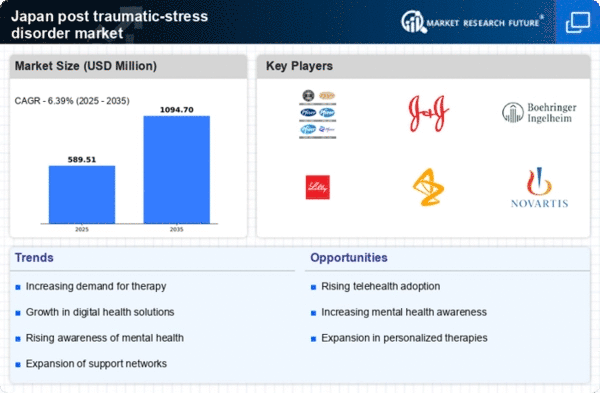Advancements in Diagnostic Tools
The post traumatic-stress-disorder market is being propelled by advancements in diagnostic tools that enhance the identification and treatment of PTSD in Japan. Innovative technologies, such as neuroimaging and biomarker analysis, are being integrated into clinical practice, allowing for more accurate diagnoses. These advancements facilitate early intervention, which is crucial for effective treatment outcomes. As healthcare providers adopt these new diagnostic methods, the post traumatic-stress-disorder market is likely to expand, driven by the need for tailored treatment plans. Moreover, the integration of digital health solutions, including mobile applications for symptom tracking and teletherapy, is becoming increasingly prevalent. This trend indicates a shift towards personalized care, which may improve patient engagement and adherence to treatment protocols. Consequently, the post traumatic-stress-disorder market stands to benefit from these technological innovations, potentially leading to better patient outcomes and increased market growth.
Rising Incidence of Trauma Cases
The post traumatic-stress-disorder market in Japan is experiencing growth due to an increase in trauma cases, particularly among the population affected by natural disasters and accidents. Japan's geographical location makes it prone to earthquakes and tsunamis, leading to a heightened awareness of mental health issues. Reports indicate that approximately 1.5 million individuals in Japan may experience PTSD at some point in their lives, which translates to a significant market opportunity. The rising incidence of trauma cases necessitates the development of effective treatment options, thereby driving demand within the post traumatic-stress-disorder market. Furthermore, the increasing recognition of PTSD as a serious mental health condition has prompted healthcare providers to prioritize mental health services, contributing to the expansion of the market. This trend suggests a potential for innovative therapies and interventions tailored to the unique needs of trauma survivors in Japan.
Cultural Shifts Towards Mental Health
In recent years, there has been a notable cultural shift in Japan regarding mental health awareness, which is positively influencing the post traumatic-stress-disorder market. Traditionally, mental health issues were stigmatized, leading to underreporting and inadequate treatment. However, as public discourse around mental health becomes more open, individuals are increasingly seeking help for PTSD. This cultural transformation is supported by various campaigns aimed at reducing stigma and promoting mental health literacy. As a result, the demand for PTSD treatment options is likely to rise, creating opportunities for healthcare providers and pharmaceutical companies. The post traumatic-stress-disorder market is expected to benefit from this shift, as more individuals recognize the importance of addressing mental health issues. Consequently, the market may see an increase in funding for research and development of new therapies, further enhancing treatment accessibility and effectiveness.
Growing Demand for Integrated Care Models
The post traumatic-stress-disorder market is increasingly influenced by the growing demand for integrated care models that address both physical and mental health needs. In Japan, there is a recognition that mental health issues, such as PTSD, often coexist with physical health conditions, necessitating a holistic approach to treatment. Integrated care models facilitate collaboration between mental health professionals and primary care providers, ensuring comprehensive support for individuals suffering from PTSD. This approach not only improves treatment outcomes but also enhances patient satisfaction. As healthcare systems in Japan evolve to adopt integrated care frameworks, the post traumatic-stress-disorder market is likely to benefit from increased accessibility to services and a more coordinated approach to care. This trend indicates a shift towards patient-centered care, which may ultimately lead to better management of PTSD and related conditions.
Increased Funding for Mental Health Research
The post traumatic-stress-disorder market in Japan is witnessing a surge in funding for mental health research, which is crucial for developing effective treatments. Government and private sector investments are being directed towards understanding the complexities of PTSD and exploring novel therapeutic approaches. This influx of funding is likely to accelerate research initiatives, leading to breakthroughs in treatment modalities. For instance, studies focusing on pharmacological interventions and psychotherapy are gaining traction, with funding allocated to clinical trials and pilot programs. The emphasis on research not only enhances the understanding of PTSD but also fosters collaboration between academic institutions and healthcare providers. As a result, the post traumatic-stress-disorder market is expected to expand, driven by the introduction of evidence-based treatments that address the specific needs of the Japanese population. This trend suggests a promising future for mental health care in Japan.

















Leave a Comment